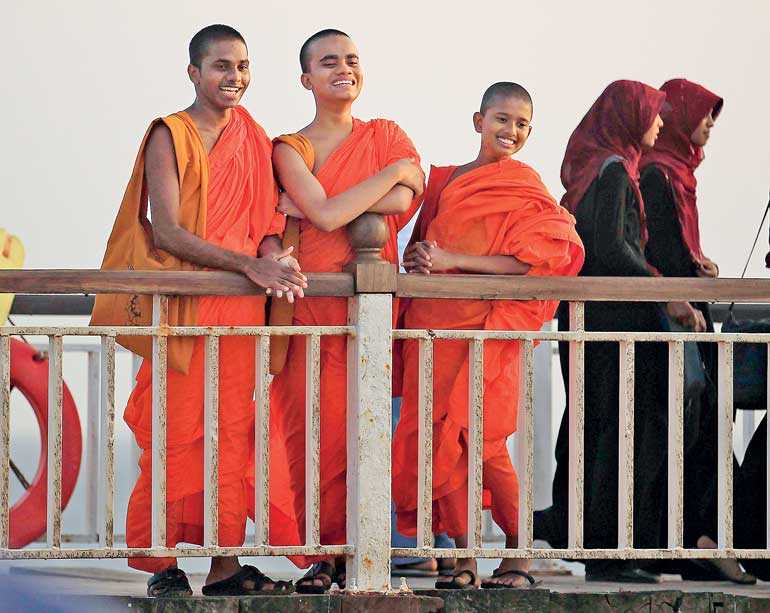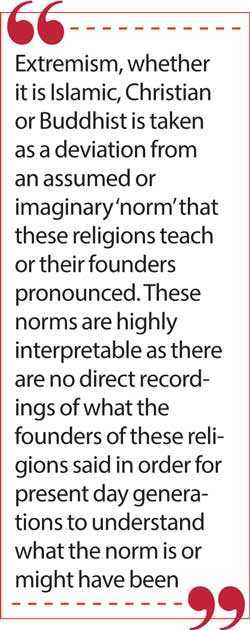Thursday Dec 04, 2025
Thursday Dec 04, 2025
Tuesday, 20 April 2021 00:00 - - {{hitsCtrl.values.hits}}

 “The burqa ban announcement caused a stir among Muslims, who saw it as yet another attack on their community. In the past few months, the Government has undertaken a number of controversial measures under the banner of fighting extremism, which have increasingly intimidated the Muslim population and disregarded rule of law
“The burqa ban announcement caused a stir among Muslims, who saw it as yet another attack on their community. In the past few months, the Government has undertaken a number of controversial measures under the banner of fighting extremism, which have increasingly intimidated the Muslim population and disregarded rule of law
principles” – Farzana Haniffa, Head of the Department of Sociology at the University of Colombo writing in the Al Jazeera on 12 April 2021
The Justice and the Law Society (JATL) of the University of Queensland is a vital organisation within the TC Beirne School of Law. An active society with diverse membership, JATL performs an important role in promoting awareness of social justice issues in the law. In a well-researched and informative article titled ‘Debate on the Burqa’ (http://www.jatl.org/blog/2014/10/19/debate-on-the-burqa), the multiple facets associated with the origins and contemporary debate on the burqa is examined in detail.
It is strongly recommended that this article is read in full by anyone interested in the debate surrounding burqa. The following passage summarises the contemporary ethos surrounding a dress that has caused so much controversy, as well as a misunderstanding of the origins and the religious reasoning behind the burqa.
The article says, quote: “Reflecting on practices across the Muslim world, it is apparent that Muslim women’s dress clearly comes with political, religious and cultural messages that an observer can decode. Dress can be seen to align the wearer with a Salafi (fundamentalist/literalist) or with a modernist interpretation of Islam. It can signify a political direction either in support of, or against, secularism, or Islamisation, or Western cultural dominance through colonisation, or globalisation. It also can reflect a cultural identity and tradition.
In Afghanistan, a woman wears the light hues of the burqa and secludes herself (purdah) to demonstrate her and her family’s honour and respect for social order. On the Arabian Peninsula she wears a black Abaya as a reflection of Salafi traditonalism, which generally restricts her movements in public non-segregated spaces. In conservative Wahhabi-informed Saudi Arabia all women, Muslim or non-Muslim are required by law to wear an Abaya in public places with religious police (muttawa) employed to enforce it. In Malaysia, she wears the vibrant colours of traditional baju kurung with tudong and is not constrained by notions of purdah as Malay women have for centuries worked with and alongside men.
However, these identifications are not static. For example, the spread of Salafi Islam from Saudi Arabia to Southeast Asia has meant that some Malaysian women who want to show their identification with that worldview now don black abaya and niqab. Wearers of face coverings also believe it brings them closer to God and personifies their piety, spirituality and the highest possible personal level of modesty.
Conversely, there are reports of young Iranian women testing the boundaries of compulsory chador dress code by adopting tighter fitting clothing and minimal or loose headscarves. In democratic Muslim Indonesia, what Muslim women wear is at the forefront of religious and legislative debate both nationally and particularly in the provinces which now have the legislative power to set and enforce their own dress codes and morality programs” unquote.
 Linking of a dress towards Islamic piety
Linking of a dress towards Islamic piety
The following passage in the above quoted excerpt is relevant in examining the impact of the burqa in Sri Lanka: “The spread of Salafi Islam from Saudi Arabia to Southeast Asia has meant that some Malaysian women who want to show their identification with that worldview now don black abaya and niqab”. It can be argued that the spread of Salafi Islam from Saudi Arabia has indeed influenced Sri Lankan Muslims as well considering that the extent of self-expression and the linking of a dress towards Islamic piety and modesty has grown and taken hold in parts of Sri Lanka perhaps in the last few decades more than ever before. Fifty years or so ago, this statement by Muslim women, in some instances on their own accord, but arguably at the dictates of men in many other cases, was not so apparent to many who lived in Sri Lanka then.
Salafism is explained well by Jonathan A.C. Brown in an article on Salafism published in the Oxford Bibiliographies (https://www.oxfordbibliographies.com/view/document/obo-9780195390155/obo-9780195390155-0070.xml). Brown states in the introduction, quote: “News reports often mention the “Wahhabi movement” or “Wahhabi Islam” without providing any context. This controversial modern Islamic movement actually represents part of a larger phenomenon in Islamic thought: Salafism.
The Salaf are the pious forbearers of Islam, usually understood as the first three generations of the Muslim community (as opposed to the Khalaf, or the later generations). The Arabic adjective Salafi and the English noun Salafism taken from it are complex terms that refer to a trend in Islamic thought that places particular emphasis on a return to the piety and principles of the Salaf as the only correct understanding of Islam.
Although all Muslim scholars look to the Salaf as role models, the majority believe that the institutions and historical developments that scholars have accepted within thought and practice over the centuries represent legitimate expressions of Islam. Establishing and adhering to schools of law (madhhab), adopting the Near Eastern traditions of Greek logic and speculative theology, and the emergence of Sufi brotherhoods were all accepted by mainstream Sunni and Shiʿite scholars.
The Salafi strain in Islamic thought, however, has questioned the authority and legitimacy of these developments, preferring to emphasise of role of hadith and the literal ways of the Salaf over such historical adoptions. Although this conservative and iconoclastic trend has always existed in Islamic thought, it is most commonly identified with two periods: the burgeoning of classical Salafism with the 14th century scholar Ibn Taymiyya (d. 1328), and the Salafism of the 18th century movements of revival and reform.
This early modern incarnation of Salafism in turn gave birth to two trends in Salafism that have flourished until today. Despite their common use of the term Salafi, these two modern movements are in fact very different, and they will be referred to here as modernist Salafism and traditionalist Salafism. Both classical Salafism and modern Salafism have clashed with the mainstream of Islamic thought, which will be referred to, for the sake of convenience, as Sunni or Shiʿite orthodoxy. Due to its controversial nature, writings on Salafism often feature heavy biases that need to be taken into consideration. Furthermore, there is scholarly disagreement over whether the term Salafism really represents a unified phenomenon; that is, is the ‘Salafism’ of Ibn Taymiyya really the Salafism of Ibn ʿAbd al-Wahhab (d. 1792) or Muhammad ʿAbduh (d. 1905)”, unquote.
Those who take the view that there is Muslim ‘extremism’ in Sri Lanka and the burqa is associated with such extremism, should take note of Brown’s statement, done with considerable research, that Salafism is a movement towards what some Islamic scholars believe as the trend in Islamic thought that places particular emphasis on a return to the piety and principles of the Salaf as the only correct understanding of Islam.
A matter for Muslims
Whether this is so or not is really a matter for Muslims and something that should be discussed and debated, understood or rejected by Muslims themselves. Salafism, or for that matter, any other branch of the Islam faith or any segment of any other religion, could be called extremist should they take the view that non-believers or non-adherents have no place in society and therefore should be sidelined or eliminated through coercion or violence. But, a movement that takes the view that they represent the real piety and principles of Islam, cannot be called an extremist movement for this reason.
Extremism, whether it is Islamic, Christian or Buddhist is taken as a deviation from an assumed or imaginary ‘norm’ that these religions teach or their founders pronounced. These norms are highly interpretable as there are no direct recordings of what the founders of these religions said in order for present day generations to understand what the norm is or might have been.
What many Buddhists appear to believe and practice today can be described at best as ritualistic, and not consistent with the teachings of Buddha. Rituals are cultural practices and not practices desired, encouraged or dictated by Buddha, but they cannot be called extremist practices. In Sri Lanka, there is a movement that believes Prince Siddhartha Gautama was a Sri Lankan and not an Indian and he became Buddha in Sri Lanka. Could one call this movement or those steeped in ritualism extremist? Misguided perhaps,
but not extremist.
In this context, determining or defining what religious extremism means is difficult, and it will mean different things to different people.
In an ideal world where logic, and internal, universal, human characteristics like love and compassion to one self and others, rather than a belief in an external divinity for one’s presence, actions and reactions, it would have been easier to desist from any form of self-defined extremism.
Life amongst human beings is far more complex, and therefore a universally accepted understanding of what religious extremism is also very complex.
Perhaps one could approach religious extremism from a different point of view. Whatever the professed religion of a human being is, and whatever they understand and believe as the teaching of that religion is, all human beings live in a society, large or small, more diverse or less diverse, and of all hues and colours, political beliefs and cultural practices. Each such society will be at peace within it and with others, if the constituents of that society maintains a balance or an equilibrium within it, and which can only come about if the constituents accept that there has to be compromise with each other in recognition of the diversity of opinion, beliefs, and practices within that society. Diversity within a society is a healthy sign if that diversity is viewed from a broader societal point of view rather than only as an advancement of individual practices of one segment within it.
Besides this, if each constituent is able to consider the point of view of another from that other constituent’s perspective, it would greatly help to ease tensions that arise within a society. It would also help if people belonging to different faiths could ponder for a moment how the founders of their faiths would look at today’s practices by their followers and how close or distant they are from the founder’s teachings. The founders may find that interpretations of their teachings and cultural edifices that have been built on such interpretations have taken over the essence of their teachings.
In Sri Lanka, it is perhaps time that the constituents of all religious faiths examined the premise of diversity with mutual regard and respect for that diversity, but, whether individual segments within the Sri Lankan society have looked at only their religious practices without consideration of how others may view such practices.
The burqa and Salafism too should be looked at in this context. People of all religious faiths should be able to coexist with each other in the Sri Lankan society that has as little turbulence a possible. Words, action and behaviour that encourages turbulence should be questioned by the very people who create that turbulence. This applies to people of all faiths, and it would mean some compromises being made, not on the principles of the faiths, but the practices of the faiths, as increasingly, the growth of practices that does not seem consistent with the principles of different faiths appears to be on the rise.